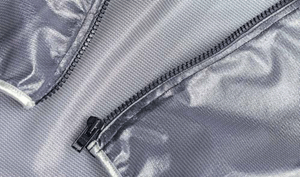
Warp-knit fabrics, a blend of style & function
New textile developments for the sports and apparel sectors from KARL MAYER show how lightness and functionality characteristics are the latest buzzwords in the clothing sector.
New textile developments for the sports and apparel sectors from KARL MAYER show how lightness and functionality characteristics are the latest buzzwords in the clothing sector.
KARL MAYER not only supplies state-of-the-art machines but also provides innovative ideas for designing textile products. A selection of new warp-knitted fabrics and models was therefore developed in time for the companys open-house event, which aimed to give new impetus to the clothing and sportswear sectors. These new textile innovations include a completely new type of Plissé fabric, a lace decorated with sports motifs, and a super-lightweight laminate for use in functional outdoor jackets, for example.
A new type of Plissé fabric
This fabric has a design similar to a pressed pattern on the reverse side and has a clearly defined Plissé construction on the right side (Figure 1). The clearly defined folded construction is arranged in differently coloured, narrow strips. The pronounced three-dimensional look of the fabric matches the current trend for the renaissance of the traditional, hand crafted look-which makes it look as if it had been made by hand-yet the bold, multi-coloured pattern in the pop art style gives it a modern twist.
The Plissé pattern features an alternating, segmented, folded construction in the white areas, thus producing an effect that enhances the dynamic look of the surface.
Plissé effects produced by folding and looping
The appearance of the fabric, which almost seems to move, is produced by combining a conventional technique with a completely new method of forming folds. The Pliss̩ effect is produced conventionally by the threading-in arrangement typical of the pattern and the relevant lapping. The relationship between the needle threading arrangement and the movement of the bars produces long yarn bands with shorter Pliss̩ yarns arranged behind them. Over a specific number of revolutions of the main shaft, the fine yarns do not form stitches but tie-in the bands later. These are laid-in in a folded arrangement as a result of the difference in length Рrather like a Venetian blind.
Unlike a typical Plissé pattern, the yarn bands are only fixed at the bases in a second segmented sequence. Each of the heads of the loops engage with the adjacent row. This creates a looser construction and produces a new braid-like effect that is quite new to warp knitting, which can also be cut without any problems. An attractive scalloped edge can be produced by cutting open a row of looping partners.
Other pattern features can be produced in this innovative Plissé construction, for example by using yarns featuring coloured heather effects, finer-count yarns, and polyamide yarns, which optimise comfort when used in clothing.
This attractive Plissé fabric was produced on an HKS 4-M EL in a gauge of E 28. The EL control facility demonstrates all its features when working a specific design such as this one, which involves segmental changing of the pattern construction.
Lace with sporty styling
KARL MAYER has developed a lace with a sporty look (Figure 2) which, instead of the conventional patterns featuring flowers and decorative effects normally used in lingerie, bridges the gap between two different style worlds. On the one hand, it brings a decorative, stylish look to rather austere sportswear and, on the other hand, it brings stringency and dynamics to the rather romantic, dainty look of bras and briefs. This lace is therefore completely in keeping with the current trend for blurring the boundaries between the different types of clothing.
The pattern of this dense lace features modern sports symbols in sweeping lines. The motifs are separated by chequered flags used to mark the end of




